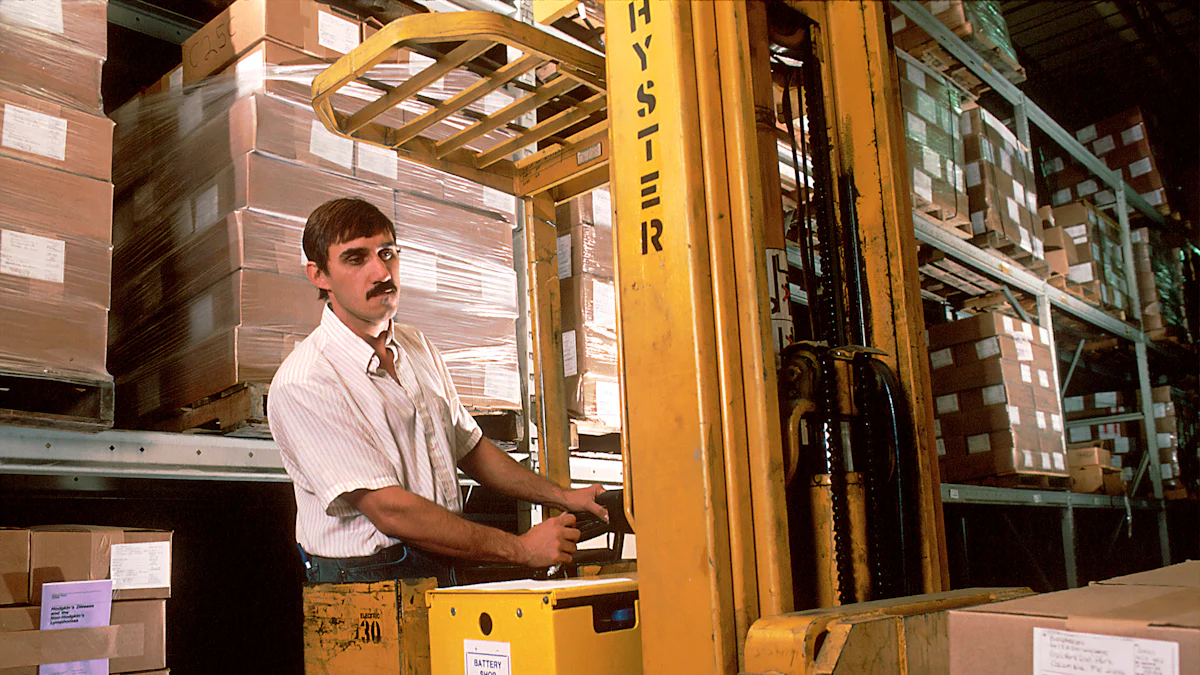
Pallet jacks are very important in moving things. They help many industries work better. They make up 60% of the money made in manufacturing. The logistics field is growing fast. It will grow by 12% from 2020 to 2030. So, using pallet jacks well is very important. This blog talks about push and pull methods. It gives tips for safe and good use to keep workplaces safe and productive.
Understanding Pallet Jacks

A Pallet Jack, also called a pallet truck or pump truck, is very important for moving things. It helps move heavy loads in warehouses and distribution centers. These tools are easy to use in small spaces and help many industries work better.
What is a Pallet Jack?
Definition and types of pallet jacks
- Pallet Jacks lift and move pallets.
- There are different kinds of Pallet Jacks, like Powered Pallet Jacks, Scissor Pallet Jacks, and Adjustable Pallet Jacks.
- Each type has its own use based on what the job needs.
Common uses in various industries
- Manufacturing: Pallet jacks help move materials easily in factories.
- Warehousing: In warehouses, pallet jacks move goods from one place to another quickly.
- Logistics: The logistics field uses pallet jacks a lot for loading and unloading, making work smooth.
Basic Operation of Pallet Jacks
How to operate a pallet jack
- To use a pallet jack, put the forks under the pallet carefully.
- Use the hydraulic system to lift the load slowly before moving it where you want it.
- Steer the pallet jack with the handle through aisles or tight spots easily.
Key components and their functions
- Forks: These slide under the pallet to lift it.
- Hydraulic System: This raises and lowers the forks smoothly.
- Wheels: These let the pallet jack move easily, helping carry heavy loads without trouble.
Push vs. Pull: A Detailed Comparison
The Push Method
When using the push method with a pallet jack, workers can use their body weight to handle heavy loads. Pushing with both hands helps avoid twisting and reaching, giving better control. This method is good for precise steering and quick moves.
Advantages of pushing:
- Uses body weight well
- Reduces twisting and reaching
- Gives better control over loads
- Allows precise steering in tight spots
When pushing is best:
- Moving through narrow aisles or crowded areas
- Turning around sharp corners or obstacles
- Needing quick stops or direction changes
The Pull Method
The pull method is sometimes used, but safety rules often suggest pushing a pallet jack instead of pulling it. Pulling might need extra care due to safety issues but can be useful when pushing isn’t possible.
Advantages of pulling:
- Another way to move loads
- Helpful when pushing is hard
- Flexible for different load types
When pulling is best:
- Moving pallets on bumpy surfaces
- Handling very heavy loads needing a different way
- Working in small spaces where pushing doesn’t work well
Common Misconceptions
There are many myths about pushing and pulling pallet jacks that need clearing up for safe use.
Myths about pushing and pulling:
- Myth 1: Pulling is always easier than pushing.
- Myth 2: Pushing only works on straight paths.
- Myth 3: Pulling gives better load control.
Clearing up myths:
“Pushing a pallet jack actually offers more control and easier movement, especially in tight areas.
Best Practices for Safe and Efficient Use

Safety Guidelines
Proper body mechanics
- Keep your back straight to avoid hurting it.
- Use your core muscles to lift and move heavy things.
- Stand with feet shoulder-width apart for better balance.
Avoiding common injuries
- Look for obstacles before using the pallet jack to stay safe.
- Wear shoes with good grip to avoid slipping.
- Move slowly and smoothly to prevent muscle strains.
Efficiency Tips
Optimizing load placement
- Put heavy items near the wheels for better balance.
- Stack loads evenly so they don’t shift during transport.
- Use straps or stoppers to secure odd-shaped items safely.
Navigating different environments
- Change your speed based on the ground and surroundings.
- Plan your path ahead, thinking about tight spaces or obstacles.
- Talk with others in shared areas to move pallets safely.
Maintenance and Care
Regular inspection routines
- Check wheels, forks, and hydraulics often for damage or wear.
- Oil moving parts as suggested by the maker for smooth use.
- Write down maintenance checks to keep track of the pallet jack’s condition over time.
Troubleshooting common issues
- If steering is hard, look for debris blocking the wheels first.
- In case of hydraulic problems, get a technician right away.
- When issues persist, stop using it until it’s fixed properly.
To sum up, knowing how pallet jacks work is key for safe and easy moving of things. Using good habits like standing correctly and placing loads well helps keep workplaces safe and working smoothly. Following these tips lowers the chance of getting hurt and makes jobs easier. People should share their thoughts and stories to keep getting better at using pallet jacks.
Post time: Jun-29-2024
